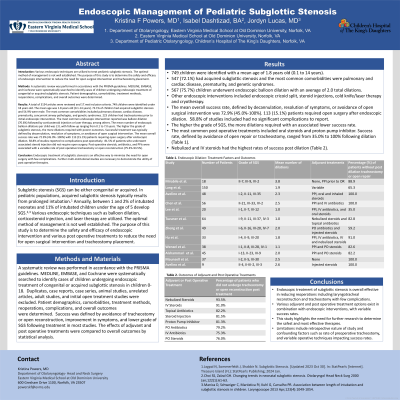Pediatric Otolaryngology
(1021) Endoscopic Management of Pediatric Subglottic Stenosis: A Systematic Review
Monday, September 30, 2024
12:00 PM - 1:00 PM EDT

Has Audio
Disclosure(s):
Kristina F. Powers, MD: No relevant relationships to disclose.
Introduction: Various endoscopic techniques are utilized to treat pediatric subglottic stenosis. The optimal method of management is not well established. The purpose of this study is to determine the safety and efficacy of endoscopic intervention to reduce the need for open surgical intervention and tracheostomy placement.
Methods: A systematic review was performed in accordance with the PRISMA guidelines. MEDLINE, EMBASE, and Cochrane were systematically searched to identify cases of children undergoing endoscopic treatment of congenital or acquired subglottic stenosis. Patient demographics, comorbidities, treatments, reoperations, complications, and outcomes were determined.
Results: A total of 3,154 articles were reviewed and 39 met inclusion criteria, which included children under 18. From them, 953 children were identified. The mean age was 2.4 years old (range: 0.4-6.7). Of the children, 82.9% had acquired subglottic stenosis, and 58.7% were male. The most common comorbidities were pulmonary disease, cardiac disease, prematurity, airway pathologies, and genetic syndromes. Also, 54.7% of children had tracheostomies prior to initial endoscopic intervention. The most common intervention reported was balloon dilation (73.7%) followed by corticosteroid injection, or laser therapy among others. The mean number of endoscopic procedures was 3.1, with follow-up ranging from 0.25 to 7 years. Postoperative treatments included oral or inhaled corticosteroids, anti-reflux medications, antibiotics, and topical mitomycin-c. Successful treatment was defined by decannulation, resolution of symptoms, or avoidance of open surgical intervention. The mean overall success rate was 76.3% (range: 46.8%-100%). No complications postoperatively were reported in 42.1% of studies.
Conclusions: Endoscopic treatment of subglottic stenosis is effective in minimizing open surgery with few complications. Further multi-institutional studies are necessary to demonstrate the utility of postoperative therapies.

Kristina F. Powers, MD
Resident
Eastern Virginia Medical School
Norfolk, Virginia, United States- JL
Jordyn Lucas, MD
Eastern Virginia Medical School, United States
